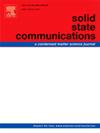Ni3Si超导电性和超电容适用性的新认识:从头算探索
IF 2.1
4区 物理与天体物理
Q3 PHYSICS, CONDENSED MATTER
引用次数: 0
摘要
近年来,M3Si块状材料因其在储能技术方面的潜力而受到广泛关注。利用密度泛函理论和广义梯度近似方法研究了Ni3Si的超导和超级电容特性。Ni3Si的临界温度为8.04 K,对应的对数平均声子频率为167.48 K。电子态密度(DOS)分析揭示了金属特征,包括费米能级附近明显的谷,这归因于Si的3s和3p轨道以及Ni的4s轨道的有限贡献。此外,该材料表现出优异的面量子电容,在-1 V时达到1003.97 μF/cm2的峰值。在相同电压下,Ni原子的三维轨道约为293.78 μF/cm2。这些发现突出了Ni3Si作为超导应用和先进超级电容器器件电极材料的前景。本文章由计算机程序翻译,如有差异,请以英文原文为准。
The new insight of superconductivity and supercapacitance applicability of Ni3Si: An ab initio exploration
In recent years, MSi bulk materials have attracted considerable attention for their potential in energy storage technologies. This work focuses on exploring the superconducting and supercapacitance properties of NiSi using density functional theory with a generalized gradient approximation approach. The critical temperature of NiSi was determined to be 8.04 K, corresponding to a logarithmic average phonon frequency of 167.48 K. Analysis of the electronic density of states (DOS) revealed metallic characteristics, including a pronounced valley near the Fermi level, attributed to the limited contributions of the and orbitals of Si and the orbital of Ni. Furthermore, the material demonstrated exceptional areal quantum capacitance, reaching a peak value of 1003.97 F/cm at -1 V. The orbitals of Ni atoms were identified as the primary contributors, accounting for approximately 293.78 F/cm at the same voltage. These findings highlight NiSi as a promising candidate for both superconducting applications and as an electrode material in advanced supercapacitor devices.
求助全文
通过发布文献求助,成功后即可免费获取论文全文。
去求助
来源期刊

Solid State Communications
物理-物理:凝聚态物理
CiteScore
3.40
自引率
4.80%
发文量
287
审稿时长
51 days
期刊介绍:
Solid State Communications is an international medium for the publication of short communications and original research articles on significant developments in condensed matter science, giving scientists immediate access to important, recently completed work. The journal publishes original experimental and theoretical research on the physical and chemical properties of solids and other condensed systems and also on their preparation. The submission of manuscripts reporting research on the basic physics of materials science and devices, as well as of state-of-the-art microstructures and nanostructures, is encouraged.
A coherent quantitative treatment emphasizing new physics is expected rather than a simple accumulation of experimental data. Consistent with these aims, the short communications should be kept concise and short, usually not longer than six printed pages. The number of figures and tables should also be kept to a minimum. Solid State Communications now also welcomes original research articles without length restrictions.
The Fast-Track section of Solid State Communications is the venue for very rapid publication of short communications on significant developments in condensed matter science. The goal is to offer the broad condensed matter community quick and immediate access to publish recently completed papers in research areas that are rapidly evolving and in which there are developments with great potential impact.
 求助内容:
求助内容: 应助结果提醒方式:
应助结果提醒方式:


